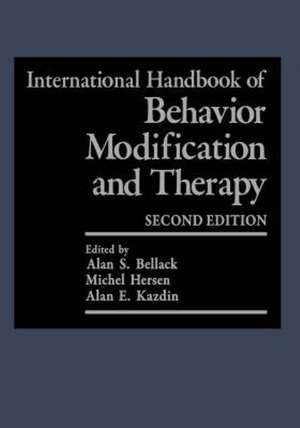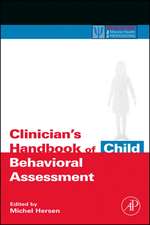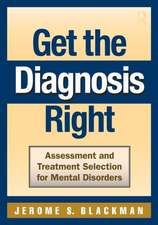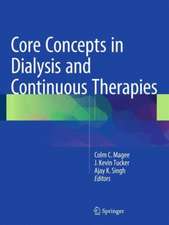International Handbook of Behavior Modification and Therapy: Second Edition
Editat de Alan S. Bellack, Michel Hersen, Alan E. Kazdinen Limba Engleză Paperback – 17 sep 2011
| Toate formatele și edițiile | Preț | Express |
|---|---|---|
| Paperback (2) | 390.13 lei 6-8 săpt. | |
| Springer Us – 12 oct 2012 | 390.13 lei 6-8 săpt. | |
| Springer Us – 17 sep 2011 | 1335.27 lei 6-8 săpt. |
Preț: 1335.27 lei
Preț vechi: 1405.55 lei
-5% Nou
Puncte Express: 2003
Preț estimativ în valută:
255.54€ • 264.76$ • 213.26£
255.54€ • 264.76$ • 213.26£
Carte tipărită la comandă
Livrare economică 21 martie-04 aprilie
Preluare comenzi: 021 569.72.76
Specificații
ISBN-13: 9781461278481
ISBN-10: 1461278481
Pagini: 912
Ilustrații: 908 p.
Dimensiuni: 178 x 254 x 50 mm
Greutate: 1.7 kg
Ediția:Softcover reprint of the original 1st ed. 1990
Editura: Springer Us
Colecția Springer
Locul publicării:New York, NY, United States
ISBN-10: 1461278481
Pagini: 912
Ilustrații: 908 p.
Dimensiuni: 178 x 254 x 50 mm
Greutate: 1.7 kg
Ediția:Softcover reprint of the original 1st ed. 1990
Editura: Springer Us
Colecția Springer
Locul publicării:New York, NY, United States
Public țintă
ResearchDescriere
It is particularly gratifying to prepare a second edition of a book, because there is the necessary impli cation that the first edition was well received. Moreover, now an opportunity is provided to correct the problems or limitations that existed in the first edition as well as to address recent developments in the field. Thus, we are grateful to our friends, colleagues, and students, as well as to the reviewers who have expressed their approval of the first edition and who have given us valuable input on how the revision could best be structured. Perhaps the first thing that the reader will notice about the second edition is that it is more extensive than the first. The volume currently has 41 chapters, in contrast to the 31 chapters that comprised the earlier version. Chapters 3, 9, 29, and 30 of the first edition either have been dropped or were combined, whereas 14 new chapters have been added. In effect, we are gratified in being able to reflect the continued growth of behavior therapy in the 1980s. Behavior therapists have addressed an ever-increasing number of disorders and behavioral dysfunctions in an increasing range of populations. The most notable advances are taking place in such areas as cognitive approaches, geriatrics, and behavioral medicine, and also in the treatment of childhood disorders.
Cuprins
I Foundations.- 1 History of Behavior Modification.- Behaviorism: As Paradigm and as Context.- On the Nature of Behaviorism.- The Concept of “Learning”.- On Labels and Terminology.- Historical Perspectives on Behavior Modification/Therapy.- The Clinical Psychology Context.- Target Behaviors.- Behavioral Techniques.- On Later Terminology—The Second Wave.- Onward and Upward?.- References.- 2 The Experimental and Theoretical Foundations of Behavior Modification.- Basic Experimental Learning Paradigms and Principles.- Classical Conditioning.- Operant or Instrumental Learning.- Avoidance Learning: A Combination of Procedures.- Implication of Conditioning Principles.- Theoretical Foundations.- The Function of Theory.- Skinner’s Antitheoretical Position.- The Impact of Formal Models.- Excitation and Inhibition Models of Behavior Change.- Counterconditioning Models of Behavior Change.- Behavior Change via Emotional Extinction.- Cognitive Models of Behavior Change.- Methodological Foundations.- The Present State of Affairs.- A Future in Question.- References.- 3 Cognitive Behavior Therapy.- Historical Foundations.- Description.- Current and Future Directions.- Summary and Conclusions.- References.- 4 Applied Behavior Analysis.- Radical Behaviorism.- Characteristics of Applied Behavior Analysis.- Principles of Applied Behavior Analysis.- Summary.- References.- II Assessment and Research.- 5 Behavioral Assessment: A Contemporary Approach.- Contemporary Behavioral Assessment.- Models of Behavioral Assessment.- Traditional Issues in Behavioral Assessment.- Emerging Issues and Directions.- Summary.- References.- 6 Observational Methods.- Designing an Observation System.- Observers: Errors and Training.- Reliability.- Validity.- Final Observations.- References.- 7 Behavioral Neuropsychology.- The Problem of Generalization.- Specific Problem Areas.- Summary.- References.- 8 Experimental Design in Group Outcome Research.- Aims.- Assumptions.- Applications.- Assessment.- Analytical Techniques.- Arguments.- Admissions and Admonitions.- A Plea for Standardization and Quantification.- Summary.- References.- 9 Single-Case Experimental Designs.- History.- Group Comparison Designs.- Experimental Analysis of Behavior.- General Issues.- General Procedures.- Basic A-B-A Designs.- Extensions of the A-B-A Design.- Drug Evaluations.- Additional Designs.- Statistical Analysis.- Replication.- Summary and Conclusions.- References.- III General Issues and Extensions.- 10 Training in Behavior Therapy.- History of Behavior Therapy Training.- Defining Behavior Therapy.- Behavior Therapy Knowledge and Skills.- Models for Training Behavior Therapy Competencies.- Training Evaluation.- Summary and Conclusions.- References.- 11 Balancing Clients’ Rights: The Establishment of Human Rights and Peer Review Committees.- Establishing Protective Mechanisms.- The Human Rights Committee.- The Peer Review Committee.- Conclusion.- Appendixes.- Appendix 1: Human Rights Committee “Due Process” Summary Report.- Appendix 2: Summary of Human Rights Committee Review of Client Individual Habilitation Plan.- Appendix 3: Peer Review Committee Summary Report.- References.- 12 Community Intervention Guided by Theoretical Development.- Unit of Analysis.- Outcomes of Participation in an Activity Setting.- Intervention.- Means of Assistance.- Principles and Guidelines for Community Psychology Consultants.- Final Comment.- References.- 13 Drugs Combined with Behavioral Psychotherapy.- Anxiety Disorders.- Depression.- Summary.- References.- IV Intervention and Behavior Change: Adults.- 14 Anxiety and Fear.- Historical Perspective.- Current Empirical Status.- Agoraphobia.- Panic.- Social Phobia.- Posttraumatic Stress Disorder.- Generalized Anxiety Disorder.- Concluding Remarks.- References.- 15 Obsessional-Compulsive Disorders.- Description and Classification.- Assessment.- Behavioral Theory.- Behavioral Treatment.- Cognitive Theory and Treatment.- Combined Behavioral and Pharmacological Treatment.- Predictors of Outcome of Behavioral Treatment.- Further Considerations.- References.- 16 Cognitive Therapy of Depression.- The Basic Cognitive Therapy Model.- General Treatment Approach.- Strategies for the Initial Sessions.- Summary.- References.- 17 Schizophrenia.- Assessment.- Behavioral Interventions for Schizophrenia.- Summary and Conclusions.- References.- 18 Adult Medical Disorders.- Historical Perspective.- Cardiovascular Disorders.- Coronary Artery Disease.- Gastrointestinal System.- Respiratory Disorders.- Pain Syndromes.- Cancer.- Psychoneuroimmunology.- Acquired Immune Deficiency Syndrome.- Computers in Behavioral Medicine.- Future Perspectives.- Summary.- References.- 19 Pain.- Respondent Conditioning Model of Chronic Pain.- Operant Conditioning Model of Chronic Pain.- Cognitive-Behavioral Perspective on Chronic Pain.- Summary and Conclusions.- References.- 20 Alcohol and Drug Problems.- The Evolution of Behavioral Treatments for Alcohol and Drug Problems.- Major Areas of Progress or Investigation since 1980.- Conclusions and Future Directions.- References.- 21 Cigarette Dependence.- Tolerance and Dependence.- Measurement of Smoking Behavior.- The Range of Treatments and Their Effectiveness.- Relapse Prevention.- Thoughts for the Future.- References.- 22 Obesity.- Definition and Epidemiology.- Complications.- The Multiple Causes of Obesity: Biological Factors.- The Multiple Causes of Obesity: Behavioral Factors.- Interaction of Biology and Behavior.- Classification and Assessment.- Treatment of Mild Obesity.- Treatment of Moderate Obesity.- Improving Maintenance of Weight Loss.- Future Directions.- A Final Recommendation.- References.- 23 Marital Distress.- and Overview.- Conceptual Developments.- Affect Research.- Cognitive Factors.- Spouse Behaviors.- Measuring Therapeutic Effectiveness.- Summary and Conclusions.- References.- 24 Interpersonal Dysfunction.- Social Skills: Conceptual/Theoretical Issues.- Assessment of Social Skill.- Social Skills Training.- Summary and Conclusions.- References.- 25 Crime and Aggression/Child and Spouse Abuse.- Assessment of Crime and Delinquency.- Summary.- References.- 26 Sexual Dysfunction.- Treatment of Sexual Dysfunction.- Treatment Techniques.- References.- 27 Sexual Deviation.- Assessment of Paraphilias.- Treatment of Paraphilias.- Treatment of Other Sexual Disorders.- Treatment of Gender Identity Disorders.- Summary.- References.- 28 Geriatric Populations.- Social Behavior.- Anxiety.- Behavioral Medicine.- Behavior Associated with Dementia.- Home Management.- Depression.- Dependency and Self Care.- ADL Training.- Future Applications.- References.- V Intervention and Behavior Change: Children and Adolescents.- 29 Stuttering.- Describing Stuttering.- Onset and Development of Stuttering.- The Search for Distal and Proximal Causes of Stuttering.- Stuttering Variability Research.- Stuttering Therapy.- Conclusion.- References.- 30 Anxiety Disorders.- Classification.- Assessment Issues.- Assessment Instruments.- Treatment.- Summary.- References.- 31 Childhood Depression: Current Status and Future Directions.- Assessment.- Deficits in Functional Domains.- Treatment.- Current Directions for Treatment Outcome Research.- Concluding Comments.- References.- 32 Conduct Disorders.- Characteristics of Conduct Disorder.- Current Treatments.- Operant Conditioning Techniques.- Parent- and Family-Based Treatment.- Cognitively Based Treatment.- Approaches to Treatment: Exemplary Studies.- Current Issues.- Conclusions.- References.- 33 Sexual Abuse of Children.- Primary Prevention and Early Disclosure.- Disclosure Crisis.- Treatment.- Summary.- References.- 34 Mental Retardation.- Current Empirical Status and Developments.- Future Perspectives and Directions.- Summary.- References.- 35 Infantile Autism.- Overview.- Diagnosis.- Etiology and Past Treatment Approaches.- Behavior Modification.- Eliminating Behavioral Excesses.- Acquisition of New Behaviors and Stimulus Functions.- Motivation.- Generalization.- Treatment Environments.- Teaching Homes.- Social Validation of Treatment Effects and Targets.- Conclusion.- References.- 36 Medical Disorders.- Behavioral Interventions in Pediatric Psychology.- Response Enhancing Techniques.- Response Reduction Techniques.- Issues for the Future.- References.- 37 Anorexia Nervosa and Bulimia Nervosa.- Assessment Framework.- General Treatment Principles.- Intervention Strategies.- Prominent Themes in Cognitive Restructuring.- Conclusion.- References.- 38 Childhood Obesity.- Definition and Measurement.- Prevalence and Significance.- Research Findings.- Closing Comments.- References.- 39 Physically Disabled Persons.- Behavior Problems.- Adaptive Living Skills.- Vocational Skills.- Social Skills.- Family Adjustment.- Conclusion.- References.- 40 Habit Disorders.- Nailbiting.- Thumbsucking.- Trichotillomania.- Concluding Comments.- References.- 41 Substance Abuse.- Overview.- Effects of Substance Abuse.- Theoretical Etiological Models.- Life Skills Training.- Summary and Conclusions.- References.











